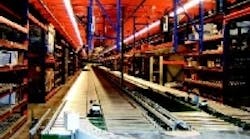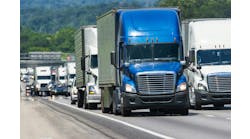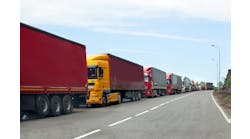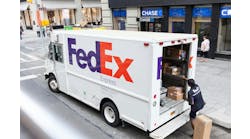Information technology product distributor CDW Corp. (Vernon Hills, Ill.) had a problem. Many of its customers were in the western U.S. and its distribution center (DC) was near Chicago. Transporting heavy computers, monitors and printers cross-country took too much time and money. The solution was obvious; build a new DC closer to the majority of customers.
In February 2006 CDW opened its 513,000 sq.-ft. Western Distribution Center in North Las Vegas, Nev. The facility more than triples the company's capacity for shipping technology products from the likes of Adobe, APC, Apple, Cisco, HP, IBM, Lenovo, Microsoft, Sony, Symantec, Toshiba and ViewSonic. CDW's 2005 sales topped $6.3 billion, and it ranks 343 on the Fortune 500.
In addition to its proximity to customers, Las Vegas has a favorable tax structure, and the city gave CDW money to help train workers, says Doug Eckrote, CDW's senior v.p. of operations. The city is also a desirable place to live. Last February, when CDW asked for 50 volunteers from its Chicago-area DC to permanently relocate to work in the new facility, more than enough people stepped forward.
Employees were asked to relocate because "CDW has a strong [company] culture, and we wanted to make sure that we imbedded it in our Vegas facility," Eckrote says. CDW hired another 120 local employees.
The Western Distribution Center's automated system can handle 96,000 outbound cases every day, compared to a maximum of 45,000 cases per day at the current facility in Vernon Hills, Ill. CDW leases the Las Vegas facility and expects to invest $35 million in equipment through 2006.
Technology is the key to improving accuracy, efficiency, productivity and speed. "Our charter is to be the fastest in the business," Eckrote says. The facility has more than 11 acres of interior floor space and over seven miles of conveyors from Dematic, Stewart Systems, Interroll and Portec.
"We have a 513,000 sq.-ft. warehouse, and only 20 Crown lift trucks and not even all of them are being used," Eckrote explains. "You don't need as many lift trucks for the efficiencies that are in the shipping side, but also on the receiving side, since you are using the conveyor to put a lot of the smaller items away."
The facility was designed to remove extra steps from the DC's processes, capturing serial numbers for example. Instead of having employees use hand scanners and struggle to move heavy boxes while searching for bar codes, boxes are conveyed through Vitronic Machine Vision scan tunnels that automatically read, from nearly every direction, manufacturers' UPC codes and serial numbers.
The scanning technology is also improving customer service. For years, CDW's customers have asked for product serial numbers printed on packing lists. Scanning at receiving captures serial numbers earlier in the process, and they are now printed on packing lists.
CDW's backorder process has also been streamlined. In its old system backordered goods were putaway, even though they were going to ship right back out the door. In the new facility backorders are cross docked.
Shipping at CDW takes place over a single eight to nine-hour shift. Receiving is done throughout the day from 5 a.m. to 9 p.m. Once product codes are read, the DC's warehouse management system (WMS) identifies where product will be routed. CDW's IT department wrote the code for its WMS, inventory management, picking and putaway systems. Commercial software runs its conveyor system and sortation equipment.
At receiving product is divided into two categories: Ready-Ship and Pick-Pack. Ready-Ship items such as computers, monitors, and printers can be shipped in the boxes they came in. Pick-Pack items like software, accessories, hard drives and modems are shipped in CDW boxes, which are automatica made by Marq box-makin machines.
The Ready-Ship items come in on skids. CDW uses a profiling system that directs the stockers to put Ready-Ship inventory away in the most efficient places. The system takes into account the velocity and dimensions of the product, putting the fastest moving items in the most efficient locations. The software tells stockers, through their Intermec RF guns, what bin location to put the product into.
Conveyors take Pick Pack products to a processing area where they are scanned and placed in plastic totes. Each tote has a license plate that contains information about the product and where it is going. Totes travel on the conveyor and are automatically diverted off to the areas where the items are to be stocked.
Conveyors also move orders to and from the 25,000 sq.-ft. product configuration center where technicians custom-configure products before shipment.
At the three-level pick module, over-head flat screens give order pickers a text description of the product and the quantity needed. The item is scanned back to the license plate to link the product with the tote. The tote is returned to the conveyor where it continues to travel and divert until the order is filled. Matco Distributors engineered the pick module with components manufactured by Excel Storage (rack), Unix (Span-Track for split-case picking flow), 3-D (pallet-flow rail), Amico (bar grating), and Wildeck (flooring structure).
A Dematic shoe sorter automatically diverts filled orders off to a packing area. Before packing material is added, the open box is weighed and its contents photographed.
"We know exactly what that order should weigh. If it is off by a very small tolerance, the box will kick off to a separate quality-control line where someone will rescan the items to make sure a mistake was not made," Eckrote explains. Customers can view the picture of their order's content online.
After a shipping label is applied on top of the packing list, outbound boxes move into a Mantissa Corp. tilt tray sorter that automatically tilts to the selected carrier's lane where conveyors feed the boxes into trucks. CDW does postal code presorts for its carriers because presorting gets orders to customers faster.



